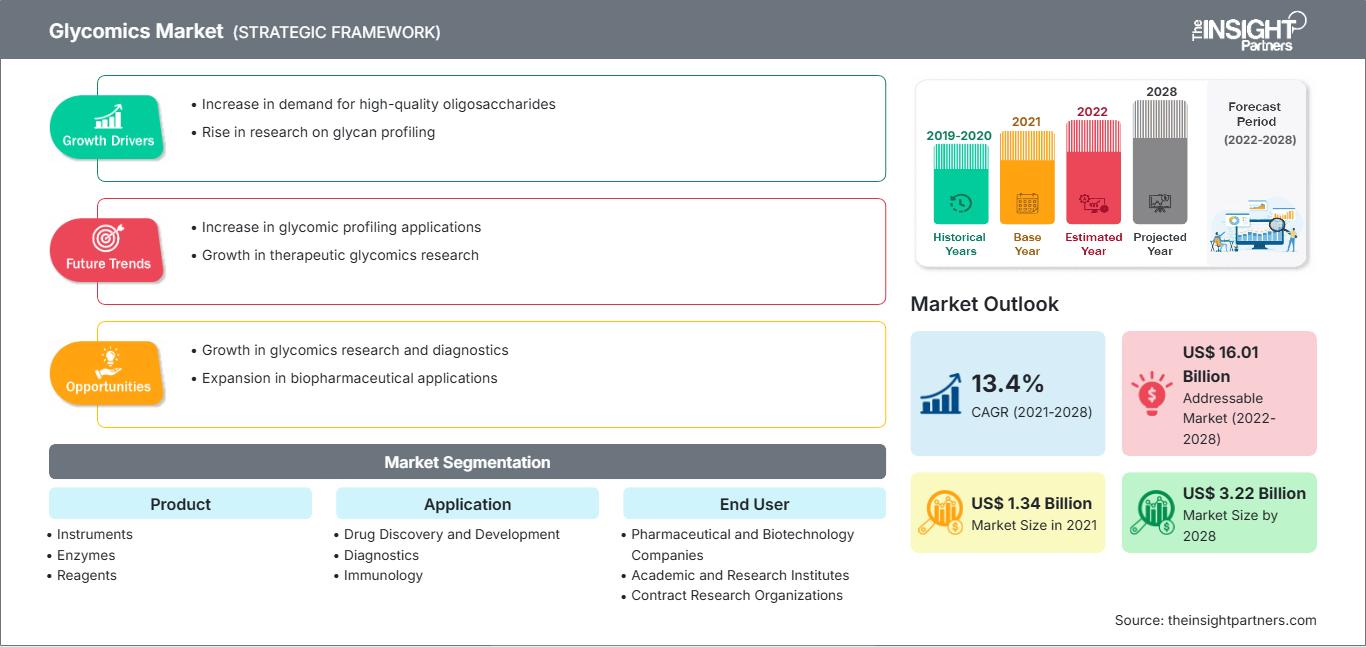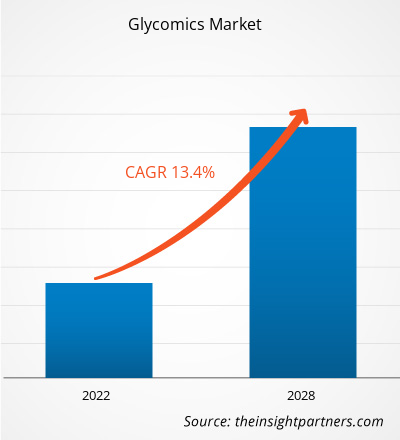[Forschungsbericht]Der Glykomik-Markt wird voraussichtlich von 1.340,80 Millionen US-Dollar im Jahr 2021 auf 3.223,30 Millionen US-Dollar im Jahr 2028 wachsen; von 2022 bis 2028 wird ein CAGR von 13,4 % geschätzt.
Glykane sind für einen Großteil der strukturellen Variation in biologischen Systemen verantwortlich, und ihre Darstellung auf Zelloberflächen wird allgemein als „Glykom“ bezeichnet. Die Glykomik ist ein aufstrebendes Forschungsgebiet, das sich auf die Struktur und Funktion von Glykanen in Zellen, Geweben oder Organismen konzentriert. Glykane sind kettenartige Strukturen aus Kohlenhydraten, die frei oder an Makromoleküle wie Lipide oder Proteine gebunden sind. Sie tragen zu einer Vielzahl biologischer Prozesse bei, wie z. B. Proteinfaltung, Zellsignalisierung und Immunerkennung. Sie werden mit verschiedenen Erkrankungen wie Krebs, Autoimmunerkrankungen und anderen in Verbindung gebracht. Der Glykomik-Markt wird durch verstärkte Glykomik-Forschung, steigende Investitionen in Forschung und Entwicklung sowie den Einsatz der Glykomik zur Behandlung verschiedener Krankheiten vorangetrieben, was zur Entwicklung neuer Behandlungsverfahren führt. Hohe Gerätekosten und ein Mangel an qualifizierten Fachkräften hemmen jedoch das allgemeine Marktwachstum. Der Bericht bietet Einblicke und eine detaillierte Analyse des Glykomik-Marktes und hebt verschiedene Parameter wie Markttrends, technologische Fortschritte, Marktdynamik und eine Analyse der Wettbewerbslandschaft der weltweit führenden Marktteilnehmer hervor. Er berücksichtigt auch die Auswirkungen der COVID-19-Pandemie auf den Markt in allen Regionen. Aufgrund der COVID-19-Pandemie konzentrierten sich viele Gesundheitsbehörden auf die pandemiebedingte Versorgung. Kürzlich haben weitere Studien zum Coronavirus Infektionsmechanismen aufgedeckt, die auf der Nutzung menschlicher Glykane durch das Virus beruhen. So zeigten GlycoNet-Forscher, dass das COVID-19-Virus über die Bindung an Glykolipide in Zellen eindringt. Forscher prüfen nun, ob besorgniserregende COVID-19-Varianten ihre Glykan-Bindungseigenschaften verändern. Somit hatte die COVID-19-Pandemie aufgrund der verstärkten Forschung weltweit positive Auswirkungen auf den Glykomik-Markt.
Passen Sie diesen Bericht Ihren Anforderungen an
Sie erhalten kostenlos Anpassungen an jedem Bericht, einschließlich Teilen dieses Berichts oder einer Analyse auf Länderebene, eines Excel-Datenpakets sowie tolle Angebote und Rabatte für Start-ups und Universitäten.
Glykomik-Markt: Strategische Einblicke

-
Holen Sie sich die wichtigsten Markttrends aus diesem Bericht.Dieses KOSTENLOSE Beispiel umfasst Datenanalysen, die von Markttrends bis hin zu Schätzungen und Prognosen reichen.
Geografiebasierte Erkenntnisse
Geografisch ist der Glykomik-Markt in Nordamerika (USA, Kanada und Mexiko), Europa (Frankreich, Deutschland, Großbritannien, Spanien, Italien und der Rest von Europa), Asien-Pazifik (China, Indien, Japan, Australien, Südkorea und der Rest von APAC), Naher Osten und Afrika (Saudi-Arabien, die Vereinigten Arabischen Emirate, Südafrika und der Rest von MEA) sowie Süd- und Südamerika unterteilt. Mittelamerika (Brasilien, Argentinien und der Rest von Süd- und Mittelamerika).
Markteinblicke
Steigender Einsatz der Glykomik bei verschiedenen Erkrankungen führt zur Entwicklung neuer Behandlungsverfahren
Da Wissenschaftler ihre Bemühungen auf das Gebiet der Glykomik konzentriert haben, haben sie begonnen, wichtige Details über die Funktionen von Glykanen und Glykosylierung im Körper zu erfahren, einschließlich der zellulären Kommunikation und darüber, was diese Faktoren über Krankheitsentwicklung und Diagnostik aussagen könnten. Die größte und am schnellsten wachsende Anwendungskategorie ist die Arzneimittelforschung und -entwicklung, hauptsächlich aufgrund der zunehmenden F&E-Aktivitäten von Pharma- und Biotechnologieunternehmen und der Ausweitung der Arzneimittelforschungsaktivitäten an universitären Forschungseinrichtungen. Um ein hochmodernes Instrument zur Krebserkennung zu kommerzialisieren, unterzeichneten Forscher des Institute for Glycomics und der University of Adelaide im April 2020 eine exklusive Lizenzvereinbarung mit Sienna Cancer Diagnostics Ltd. Diese Forscher haben ein spezielles Protein namens SubB2M entwickelt, das ausschließlich an ein Zuckermolekül bindet, das nur in Krebszellen vorkommt. Dieses Protein könnte die Krebserkennung revolutionieren. Darüber hinaus vergab der National Health and Medical Research Council (NHMRC) im Januar 2022 Zuschüsse in Höhe von insgesamt über 1.100.000 US-Dollar an Forscher des Institute of Glycomics, um sie bei der Entwicklung neuer Medikamente zur Behandlung multiresistenter Gonorrhoe-Infektionen zu unterstützen.
Produktbasierte Erkenntnisse
Nach Produkten ist der globale Glykomik-Markt in Enzyme, Instrumente, Kits und Reagenzien unterteilt. Im Jahr 2021 wird das Enzymsegment den größten Marktanteil ausmachen; Darüber hinaus wird erwartet, dass der Glykomik-Markt zwischen 2022 und 2028 die höchste durchschnittliche jährliche Wachstumsrate (CAGR) verzeichnet.
Anwendungsbasierte Erkenntnisse
Basierend auf der Anwendung ist der globale Glykomik-Markt in die Bereiche Arzneimittelforschung und -entwicklung, Diagnostik, Immunologie, Krebs und weitere unterteilt. Das Segment Arzneimittelforschung und -entwicklung dürfte 2021 den größten Marktanteil halten. Allerdings wird erwartet, dass das Diagnostiksegment im Prognosezeitraum die höchste CAGR verzeichnet. Die wichtigsten treibenden Faktoren für das Anwendungssegment sind die zunehmende Forschung zu seltenen Krankheiten, der steigende Bedarf an Arzneimittelentwicklung und das wachsende Bewusstsein für Frühdiagnosen.
Glykomik
Regionale Einblicke in den Glycomics-MarktDie Analysten von The Insight Partners haben die regionalen Trends und Faktoren, die den Glykomik-Markt im Prognosezeitraum beeinflussen, ausführlich erläutert. In diesem Abschnitt werden auch die Marktsegmente und die geografische Lage in Nordamerika, Europa, dem asiatisch-pazifischen Raum, dem Nahen Osten und Afrika sowie Süd- und Mittelamerika erörtert.
Umfang des Glycomics-Marktberichts
| Berichtsattribut | Einzelheiten |
|---|---|
| Marktgröße in 2021 | US$ 1.34 Billion |
| Marktgröße nach 2028 | US$ 3.22 Billion |
| Globale CAGR (2021 - 2028) | 13.4% |
| Historische Daten | 2019-2020 |
| Prognosezeitraum | 2022-2028 |
| Abgedeckte Segmente |
By Produkt
|
| Abgedeckte Regionen und Länder |
Nordamerika
|
| Marktführer und wichtige Unternehmensprofile |
|
Dichte der Marktteilnehmer im Glykomik-Markt: Verständnis ihrer Auswirkungen auf die Geschäftsdynamik
Der Glykomik-Markt wächst rasant, angetrieben durch die steigende Endverbrauchernachfrage aufgrund von Faktoren wie sich entwickelnden Verbraucherpräferenzen, technologischem Fortschritt und einem stärkeren Bewusstsein für die Produktvorteile. Mit steigender Nachfrage erweitern Unternehmen ihr Angebot, entwickeln Innovationen, um den Verbraucherbedürfnissen gerecht zu werden, und nutzen neue Trends, was das Marktwachstum weiter ankurbelt.

- Holen Sie sich die Glykomik-Markt Übersicht der wichtigsten Akteure
Endnutzerbasierte Erkenntnisse
Basierend auf dem Endnutzer ist der globale Glykomik-Markt in Pharma- und Biotechnologieunternehmen, akademische und Forschungsinstitute sowie Auftragsforschungsinstitute segmentiert. Das Segment der Pharma- und Biotechnologieunternehmen wird 2021 den größten Marktanteil halten und im Prognosezeitraum voraussichtlich die höchste durchschnittliche jährliche Wachstumsrate (CAGR) aufweisen. Die Akteure des Glykomik-Marktes verfolgen organische Strategien wie Produkteinführung und -expansion, um ihre Präsenz und ihr Produktportfolio weltweit zu erweitern und die wachsende Nachfrage zu decken. Einige wichtige Akteure des Glykomik-Marktes sind unter anderem Merck KGaA, Agilent Technologies, Inc., New England Biolabs, Thermo Fisher Scientific Inc., Waters Corporation, Asparia Glycomics, Bruker Corporation, Takara Bio Inc., S-BIO und Shimadzu Corporation.
- Historische Analyse (2 Jahre), Basisjahr, Prognose (7 Jahre) mit CAGR
- PEST- und SWOT-Analyse
- Marktgröße Wert/Volumen – Global, Regional, Land
- Branchen- und Wettbewerbslandschaft
- Excel-Datensatz
Aktuelle Berichte
Erfahrungsberichte
Grund zum Kauf
- Fundierte Entscheidungsfindung
- Marktdynamik verstehen
- Wettbewerbsanalyse
- Kundeneinblicke
- Marktprognosen
- Risikominimierung
- Strategische Planung
- Investitionsbegründung
- Identifizierung neuer Märkte
- Verbesserung von Marketingstrategien
- Steigerung der Betriebseffizienz
- Anpassung an regulatorische Trends






















 Kostenlose Probe anfordern für - Glykomik-Markt
Kostenlose Probe anfordern für - Glykomik-Markt